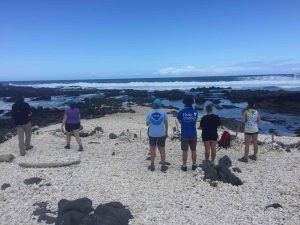Aloha ʻĀina refers to a sense of place, a central concept in Hawaiian culture. A connection to a particular place was a common theme in many of the conversations we had with people on the islands of Oahu and Hawai’i over the last two weeks. We have been using these conversations to calibrate our own places in the complex world of marine conservation. The term conservation means something different to everyone, and we must each find our own place in conversations about biodiversity, community and sustainability.

For me, conservation means finding ways to coexist with the species and ecosystems that we value and upon which we ultimately depend. Hawai’i is particularly interesting from this perspective because of the challenges posed by serial waves of human immigration and habitat modification on a remote island archipelago.

Emblematic of these challenges is the Hawaiian monk seal. Extirpated from the main Hawaiian Islands by the Polynesians who first colonized Hawai’i, the species persisted in the remote atolls of the Northwestern Hawaiian Islands. Now it is recolonizing its former range in the Main Hawaiian Islands and once again coming into frequent contact with humans.
We started our trip with a meeting with the federal biologists and managers responsible for the conservation of this iconic species. We ended our trip this afternoon with a trip to Ke Kai Ola, the new monk seal hospital on Hawai’i. We learned about the seven juvenile monk seals recently returned to the Northwestern Hawaiian Islands after being fattened up over the winter at Ke Kai Ola.

But we also learned about an incident yesterday in which RK-30, a pregnant 17-year old monk seal, was attacked by a resident of Kauai. Fortunately, she survived the attack, just as she had survived past entanglements and shark attacks. She, like her species, is a survivor. For conservation of monk seals to succeed, we need to learn how to share our place with RK-30 and her kind.
I’d like to close out this year’s class blog by saying mahalo to everyone who took time out of their busy schedules over the past two weeks to talk with us and to share their views on conservation in Hawai’i.

